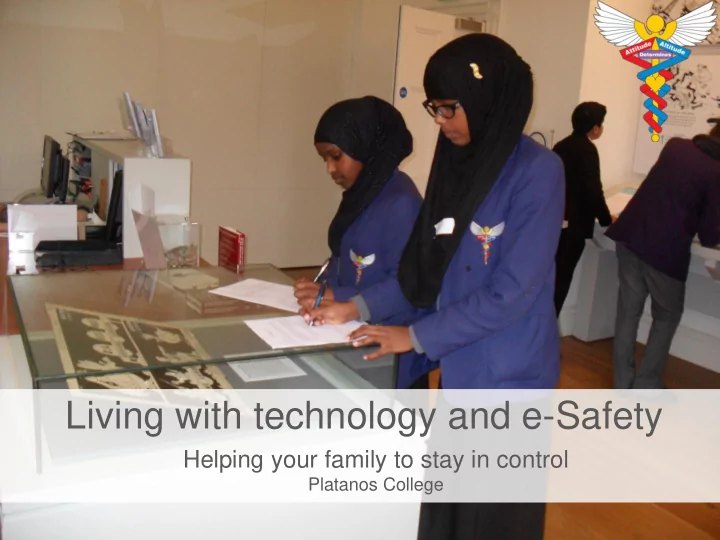

Living with technology and e-Safety Helping your family to stay in control Platanos College
The workshop • We are going to cover: 1. The technologies children, young people and their families are using 2. Some of the challenges and issues they bring 3. Some practical ideas and tools to help you to stay in control
What technologies are you and your family using?
Top 10 internet activities Activity Top 10 internet activities carried out at least once a week, by age: 2012 (%) 5-7yrs 8-11yrs 12-15yrs Schoolwork / homework 38 67 82 Online games 47 51 47 Surfing / browsing 15 38 71 Social networking 3 19 75 Videos 9 25 56 Music 7 19 53 Avatar websites 33 36 15 TV 24 21 28 Wikipedia website 4 19 38 Instant messaging 1 11 45
Media in children ’ s bedrooms Activity % of children who have the following media in their bedroom (2012) TV Games DVD/Blu-ray Digital TV Internet Radio Digital video console (PC/Laptop) (DVR) 3-4 year olds 33 15 17 8 1 3 4 5-7 year olds 43 36 24 14 3 7 6 8-11 year olds 58 60 31 21 14 19 8 12-15 year 73 64 41 37 39 30 14 olds
Use of tablet computers Activity % of children who use a tablet computer 2010 2011 2012 5-7 year olds 0 2 11 8-11 year olds 2 6 13 12-15 year olds 5 6 17 * Ofcom – March 2012
Smartphone ownership Activity % of children who own a smartphone 2011 2012 5-7 year olds 5 4 8-11 year olds 12 15 12-15 year olds 41 62
Changing technologies
Today’s technologies
60 seconds of the Internet
Knowledge vs. wisdom Knowledge Wisdom Understanding how to behave in Many children pick up technology quicker! a virtual world.
What are the main benefits of digital technologies for your family?
Key challenges / issues
Did you know…? * Ofcom UK Children ’ s Media Literacy Report
But remember! YOU have the PARENTAL WISDOM
So… what should you do now? 1. Get involved in your children ’ s online activity at home and TALK Check you know what applications they are using, especially chat rooms and games played with others online. Ask who their ‘ e-pals ’ are. Get them to teach you about how things work. 2. Support the school Sign the Acceptable Use Policy and take an active interest in what your children are doing in ICT at school. 3. Encourage Internet use that builds on offline activities It helps to keep the computer in a family room not tucked away in a child ’ s bedroom. Help your children to use the Internet for homework and leisure interests. 4. Use some of the tools on the computer to help you
Conversation starters
Tools Passwords Google SafeSearch YouTube Safety Mode Parental controls on your Internet service (e.g. BT Family Protection) Parental controls and separate accounts on your computer Parental controls on your mobile phone (e.g. Vodafone Content Control) Parental controls on your games console (e.g. Nintendo DS and important control to turn off 3d for children under 7, Xbox and restriction of Xbox live) Facebook privacy controls
1. Passwords Why are passwords so important?
Passwords: what you can do Change passwords for important accounts regularly (banking, iTunes, Amazon, etc.) Make sure you know who knows them Choose strong passwords (a good combination of uppercase and lowercase characters, numbers and symbols)
2. Google SafeSearch
Google SafeSearch SafeSearch helps you to keep adult content out of search results by screening websites that contain sexually-explicit content and removing them from the search results.
3. YouTube Safety Mode
4. Internet provider parental control
Internet provider parental control You can set different age limits for your children so you can make sure they only see content appropriate to their age They enable you to set limits on how long your child stays online and when they go online You can allow or block specific programs, like Instant Messenger, or hardware like webcams
5. Parental Controls on your mobile
Mobile Parental Controls
Mobile Parental Controls Vodafone Guardian app Digital Parenting magazine The Vodafone Guardian app helps to Expert View articles, ‘ How to ’ guides and keep children safer when using a Take Action checklists will help you feel smartphone more confident about getting involved
6. Parental Controls with Social Media
Facebook privacy controls
Sharing on Facebook Click on ‘ customise settings ’ in the ‘ Sharing on Facebook ’ section Choose who your child is happy seeing and commenting on things they share, post or are tagged in – your child can choose ‘ Everyone ’ , ‘ Friends of Friends ’ or ‘ Friends ’
Basic directory information Certain information is visible to everyone on Facebook and can ’ t be customised Other basic settings can be changed Go to ‘ Account/Privacy Settings ’ Click on ‘ View Settings ’ in the ‘ Basic Directory Information ’ Decide who can see particular information
Looking for more information?
Useful links • Vodafone Digital Parenting: vodafone.com/parents • Mumsnet: www.mumsnet.com • ParentPort: www.parentport.org.uk • The Parent Zone: www.theparentzone.co.uk • Child Exploitation & Online Protection Centre: www.ceop.police.uk • Missing & Exploited Children: www.missingkids.com • Childnet International: www.childnet.com • CEOP: www.thinkuknow.co.uk/parents/parentsguide • UK Safer Internet Centre: www.saferinternet.org.uk
Recommend
More recommend